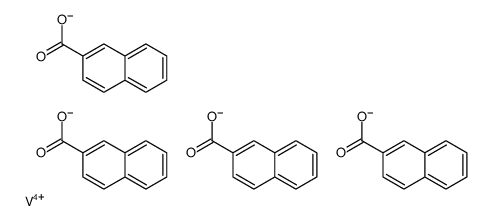68553-60-6
| Name | Vanadium Naphthenate Oxide in Naphthenic Acid |
|---|---|
| Synonyms |
EINECS 271-395-7
MFCD00148763 naphthalene-2-carboxylate,vanadium(4+) |
| Density | 1.04 g/cm3 |
|---|---|
| Molecular Formula | C44H28O8V |
| Molecular Weight | 735.63000 |
| Flash Point | 30ºC |
| Exact Mass | 735.12200 |
| PSA | 160.52000 |
| LogP | 4.81320 |
| Water Solubility | Insoluble in water. |
|
Section 1: Product Identification Chemical Name:Vanadyl naphthenate, 35% in naphthenic acid (2.8-3.2% V) CAS Registry Number:68553-60-6 Formula:Vanadyl salt of napthenic acid EINECS Number:none Chemical Family:metal carboxylate Synonym:Naphthenic acid, vanadium salt, in alkylated cycloalkane carboxylic acids.
Section 2: Composition and Information on Ingredients IngredientCAS NumberPercentACGIH (TWA)OSHA (PEL) Title Compound68553-60-635%no datano data naphthenic acid1338-24-565%no datano data Section 3: Hazards Identification Emergency Overview:Severely irritating to eyes, skin and respiratory tract. May be harmful if swallowed. Primary Routes of Exposure:Ingestion, eyes, inhalation, skin Eye Contact:Causes severe irritation to the eyes. Skin Contact:Causes moderate to severe irritation of the skin. Inhalation:Vapor will severely irritate the nose, mucous membranes and respiratory tract. Ingestion:Ingestion may cause gastrointestinal distress, nausea, dizziness, weakness. Acute Health Affects:Irritating to skin, eyes and respiratory tract. Chronic Health Affects:No information available on long-term chronic effects. NTP:No IARC:No OSHA:No SECTION 4: First Aid Measures Immediately flush the eyes with copious amounts of water for at least 10-15 minutes. A victim may need Eye Exposure: assistance in keeping their eye lids open. Get immediate medical attention. Wash the affected area with soap and water. Remove contaminated clothes if necessary. Seek medical Skin Exposure: assistance if irritation persists. Remove the victim to fresh air. Closely monitor the victim for signs of respiratory problems, such as difficulty Inhalation: in breathing, coughing, wheezing, or pain. In such cases seek immediate medical assistance. Ingestion:Seek medical attention immediately. Keep the victim calm. Give the victim water (only if conscious). SECTION 5: Fire Fighting Measures Flash Point:>350 °F Autoignition Temperature:no data Explosion Limits:none Extinguishing Medium:carbon dioxide, dry powder or foam If involved in a fire, fire fighters should be equipped with a NIOSH approved positive pressure self-contained Special Fire Fighting Procedures: breathing apparatus and full protective clothing. Hazardous Combustion andIf involved in a fire this material may emit toxic organic fumes. Decomposion Products: Unusual Fire or Explosion Hazards: No unusual fire or explosion hazards. SECTION 6: Accidental Release Measures Eliminate all ignition sources. Small spills may be adsorbed into diatomaceous earth, sand, or other suitable Spill and Leak Procedures: adsorbent, and swept up. SECTION 7: Handling and Storage Handling and Storage:Store in a sealed container. Keep away from heat and moisture. SECTION 8: Exposure Controls and Personal Protection Eye Protection:Always wear approved safety glasses when handling a chemical substance in the laboratory. Skin Protection:Wear appropriate chemical resistant gloves and protective clothing. Ventilation:Material may form a vapor. If possible, handle the material in an efficient fume hood. If ventilation is not available a respirator should be worn. The use of respirators requires a Respirator Respirator: Protection Program to be in compliance with 29 CFR 1910.134. Ventilation:Material may form a vapor. If possible, handle the material in an efficient fume hood. Additional Protection:No additional protection required. SECTION 9: Physical and Chemical Properties Color and Form:viscous liq. Molecular Weight:not applicable Melting Point:no data Boiling Point:no data Vapor Pressure:no data Specific Gravity:1.04 Odor:organic odor Solubility in Water:insoluble SECTION 10: Stability and Reactivity Stability:air and moisture stable liquid Hazardous Polymerization:no hazardous polymerization Conditions to Avoid:none Incompatibility:oxidizing agents, bases Decomposition Products:Carbon dioxide, carbon monoxide, organic vapors, and metal oxides and carbonates. SECTION 11: Toxicological Information RTECS Data:No information available in the RTECS files for title compound. Naphthenic acid: Oral (rat) LD50: 3g/Kg; Carcinogenic Effects:none Mutagenic Effects:none Tetratogenic Effects:none SECTION 12: Ecological Information Ecological Information:No information available SECTION 13: Disposal Considerations Disposal:Dispose of according to local, state and federal regulations. SECTION 14: Transportation Shipping Name (CFR):Non-hazardous Hazard Class (CFR):NA Additional Hazard Class (CFR):NA Packaging Group (CFR):NA UN ID Number (CFR):NA Shipping Name (IATA):Non-hazardous Hazard Class (IATA):NA Additional Hazard Class (IATA):NA Packaging Group (IATA):NA UN ID Number (IATA):NA SECTION 15: Regulatory Information TSCA:Listed in the TSCA inventory. SARA (Title 313):Title compound not listed. Second Ingredient:Not listed in the TSCA inventory SECTION 16 - ADDITIONAL INFORMATION N/A |
| Risk Phrases | R36/37/38 |
|---|---|
| Safety Phrases | S26-S36-S37-S39 |
| RIDADR | UN 3285 6.1/PG 3 |
| Packaging Group | III |
| Hazard Class | 6.1 |
